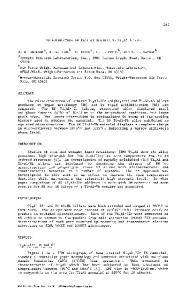Microstructure and Deformation of Rapidly Solidified TiAl Alloys
- PDF / 2,165,749 Bytes
- 11 Pages / 420.48 x 639 pts Page_size
- 31 Downloads / 437 Views
MICROSTRUCTURE AND DEFORMATION OF RAPIDLY SOLIDIFIED TiAl ALLOYS SHYH-CHIN HUANG and ERNEST L. HALL General Electric Corporate Research and Development Center, Schenectady, NY 12301
P.O.
Box 8,
ABSTRACT Binary TiAl alloys containing 45-60 at.% Al were studied in detail in order to understand the fundamental deformation behavior and to establish a guideline for advanced alloy design. Because the formation of this compound involves a peritectic reaction, all alloys were processed by the melt spinning technique to minimize segregation. Microstructural and mechanical characterizations were carried out on both the as-solidified and consolidated materials. The results are presented to address the issues of (1) the equilibrium phase relationship, (2) the rapid solidification microstructure, (3) the room temperature deformation behavior, (4) the brittle/ductile transition, (5) the temperature dependence of yield stress, and (6) the implication on alloying effects. Several examples of ternary alloys are given. INTRODUCTION The intermetallic compound TiAl has attractive properties such as high melting temperature, low density, high modulus, and good oxidation resistance [1,2]. This intermetallic thus has the potential for high temperature structural applications, particularly if its low temperature ductility can be improved. The deformation behavior of TiAl is inherently related to its fct crystal structure [3-9], which orders in such a way that Ti and Al atoms occupy alternating (002) planes [10]. Anisotropic deformation arises, involving both 1/2[110] unit dislocations, and [101] and [011] superdislocations. In addition, the ductility of polycrystalline TiAl is strongly affected by microstructure [11-13]. In order to understand the fundamental deformation behavior and to establish a guideline for advanced alloy design, binary TiAl alloys were studied in detail. Because the formation of this compound involves a peritectic reaction, all alloys were processed by the rapid solidification technique of melt spinning to avoid segregation. Equilibrium Ti-Al phase diagram near the stoichiometry was reexamined to explain the observed solidification and heat treated microstructures. The effects of several ternary element additions were also investigated.
EXPERIMENTAL Each alloy studied in this work was processed into ribbon by melt Consolidation of the ribbons was carried out by cold comspinning [14]. After paction, followed by hot isostatic pressing and finally extrusion. consolidation, the samples were heat treated at 1200-1400°C for 2 hours. The mechanical behavior of consolidated specimens was determined using The microstructures four-point bending tests and tensile tests in vacuum. of the samples were studied by optical and analytical transmission electron microscopy (AEM). For the deformation substructures, AEM specimens were taken from the gauge section of the tensile bars or from the surface of the bend bars experiencing the maximum tensile strain.
Mat. Res. Soc. Symrp. Proc. Vol. 133. 01989 Materials Research Society
Data Loading...











